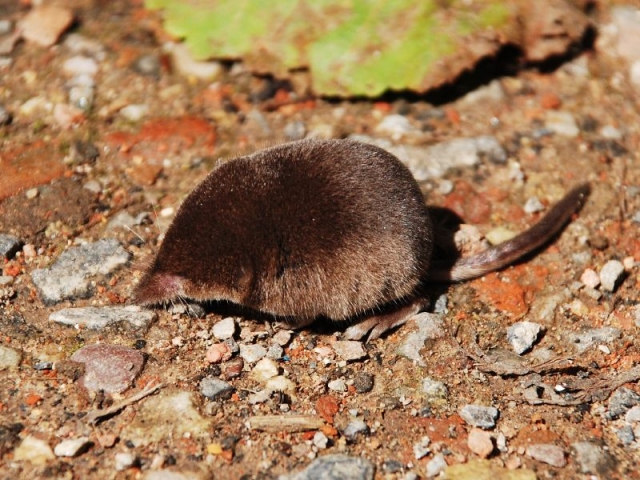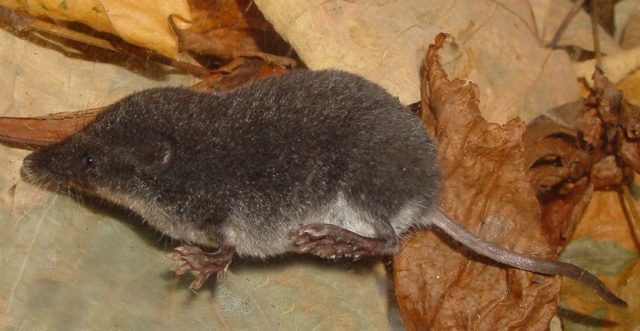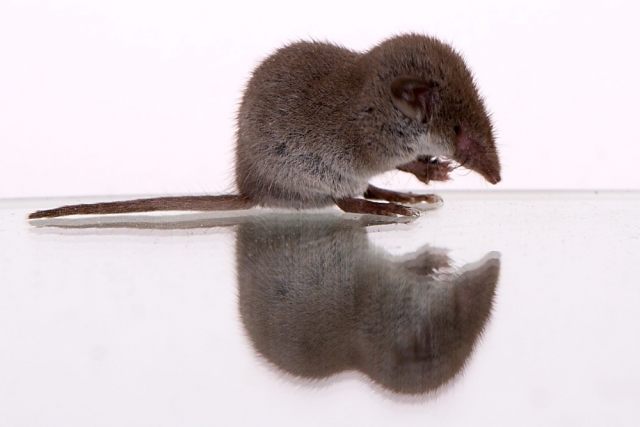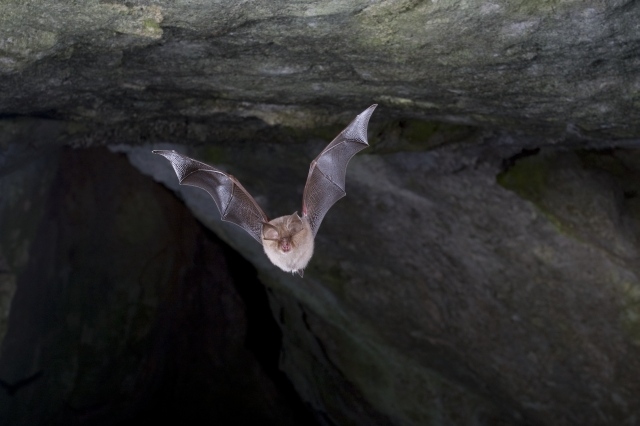Florian Heigl
Eurasian pygmy shrew
Description
The Eurasian pygmy shrew is one of the smallest land-dwelling mammals in Europe. The snout-vent length is 42 to 66 mm, the tail length 35 to 46 mm and the weight 2.6 to 5.9 g. The upperparts and the flanks are plain brown, the underpart is grey.
The Eurasian pygmy shrew resembles the Eurasian shrew, a relative of the red-toothed shrew genus, but it is much smaller than the latter. Compared to the Eurasian shrew, it has a thicker and longer tail. Another distinguishing feature is the colouration of the Eurasian shrew, which appears bicoloured due to a dark dorsal colouration with distinctly lighter flanks.
Alpine, Eurasian water shrew and Mediterranean water shrew have black to black-grey fur. The latter two species are significantly larger and more robust than the Eurasian pygmy shrew. The only distantly related native white-toothed shrews, i.e. the bicoloured shrews, European white-toothed shrews and lesser white-toothed shrews, differ from the Eurasian pygmy shrew, among other things, in that the auricles are not covered by hairs and the tips of the teeth are white instead of dark brown, as well as in that longer hairs occasionally stick out from the tail.
Habitat
The Eurasian pygmy shrew inhabits wet meadows, moors and mixed forests.
The text is a translation of an excerpt from Wikipedia (https://de.wikipedia.org/wiki/Zwergspitzmaus). On wikipedia the text is available under a „Creative Commons Attribution/Share Alike“ licence. Status: 09 August 2021
Mediterranean water shrew
Description
The snout-vent length is 65-86 mm and the tail length 40-56 mm. The animals weight 6-16 g, rarely up to 18.5 g. The fur is slate black on the upperparts, the underpart is grey to white. The species shows less strong adaptations to life in water than the similar Eurasian water shrew, a bristle fringe on the tail and hind feet is only indicated.
Habitat
The Mediterranean water shrew inhabits eutrophic riparian vegetation on stillwaters, slow-flowing streams and rivers, and marshes from lowland to 1850 m altitude. Habitat use is apparently significantly influenced by competition with the water shrew. Where the Eurasian water shrew is absent, the Mediterranean water shrew lives more aquatically and also increases in size.
The text is a translation of an excerpt from Wikipedia (https://de.wikipedia.org/wiki/Sumpfspitzmaus). On wikipedia the text is available under a „Creative Commons Attribution/Share Alike“ licence. Status: 09 August 2021
Eurasian water shrew
Description
The species is the largest shrew in Europe. The snout-vent length is 70-96 mm and the tail length 47-77 mm. The animals weight 15-20, rarely up to 25 g. The coat is glossy black on top, the underpart is variably silvery white to blackish brown, often with a rusty brown overcoat. The species is well adapted to life in water. The fur is long and dense, the underpart of the tail has a bristled keel along its entire length, which serves as a rudder, and the hind feet have bristles that aid propulsion. The water shrew is one of the few poisonous mammals in Central Europe. The secretion produced by venom glands located under the tongue is lethal in animals up to mouse size.
Habitat
The Eurasian water shrew inhabits near-natural shore areas of all kinds of water bodies including seashores, but also swamps, wet forests and meadows and in the north of its range even fields. The species occurs from the lowlands up to 2500 m altitude.
The text is a translation of an excerpt from Wikipedia (https://de.wikipedia.org/wiki/Wasserspitzmaus). On wikipedia the text is available under a „Creative Commons Attribution/Share Alike“ licence. Status: 09 August 2021
Lesser white-toothed shrew
Description
The lesser white-thoothed shrew is the smallest of the three species of white-toothed shrews (genus Crocidura) found in Europe. The snout-vent length is 50 to 75, rarely up to 80 mm, the tail length 25 to 40 mm and the weight 4.0 to 7.5 g. The upperparts are brown-grey, the flanks and the underparts are grey and occasionally have a yellowish tinge. The colouration of the under- and upperparts is not sharply separated.
Habitat
The lesser white-toothed shrew inhabits woodland-free, extensively used and warm open habitats such as fallow land, field and path margins, sedimentation vegetation, gardens, scree slopes and dry stone walls from lowland to about 700 m altitude. The species often lives - and in the north of its range almost exclusively - near human settlements. From September onwards, the animals increasingly migrate into buildings to hibernate there.
The text is a translation of an excerpt from Wikipedia (https://de.wikipedia.org/wiki/Gartenspitzmaus). On wikipedia the text is available under a „Creative Commons Attribution/Share Alike“ licence. Status: 09 August 2021
Bicoloured shrew
Description
The snout-vent length is 65 to 85 mm, the tail length 28 to 43 mm and the weight 7 to 15 g. The upperparts are brown-grey, the flanks and the underparts are sharply contrasting white-grey.
Habitat
The bicoloured shrew inhabits woodland-free, extensively used open habitats such as fallow land, abandoned grassland, roadsides, fields and gardens from lowland to about 700 m altitude. At certain times of the year, the animals move to areas with more cover and humid terrain. Especially in the area of the northern range limit, the species is closely tied to human settlements; in Poland, for example, it is much more common in larger towns than in small towns and villages. In the rest of the species' range, houses are visited mainly for hibernation.
The text is a translation of an excerpt from Wikipedia (https://de.wikipedia.org/wiki/Feldspitzmaus). On wikipedia the text is available under a „Creative Commons Attribution/Share Alike“ licence. Status: 09 August 2021
Northern mole
Description
The Northern mole reaches a snout-vent length of 11.3 to 15.9 cm, the tail becomes 2.5 to 4.0 cm long. The weight varies from 72 to 128 g. The Northern mole is well adapted to the underground burrowing way of life. The body shows a cylindrical shape, the neck is short and the conically shaped head ends in a pointed snout. The short tail retracts at the base, usually held upright. The broad forelimbs are short, broad and laterally oriented. All five fingers bear extraordinary claws. The hands are turned outwards, forming an effective digging tool. In contrast, the hindlimbs, which grow to 1.7 to 2.8 cm in length, appear rather graceful, the claws on each of the five toes appear much less developed.
Externally visible ears are not present. The eyes lie in a palpebral fissure. Their size is greatly reduced, but they have not completely lost their function. The soft fur, which does not have a stripe and thus does not offer any resistance during locomotion in the corridors and tunnels, is usually dark grey to black in colour with a slightly lighter tone on the underparts. However, colour anomalies occur in individual animals, ranging from white-grey silver to piebald, cream and yellow to orange and coffee brown. The limbs are hairless, as is the tail.
Habitat
They inhabit a variety of different habitats, but all have in common a thick soil layer, deep enough to create burrows and tunnels, with an abundant food supply. In general, the presence of the Northern mole is positively linked to the regional abundance of earthworms. As a result, it avoids acidic soils; the threshold value is reached at a pH value of 4.5 or higher, as the density of earthworms decreases rapidly here. It also avoids heavily industrialised regions with sometimes considerable pollution combined with a decline in soil quality. The altitudinal distribution covers the areas from sea level up to around 2700 m altitude. Originally, the Northern mole colonised deciduous forest landscapes, but today it can also be found on pastures, fallow land, in parks and in gardens. It also spreads into urban areas, whereby green spaces with a minimum area of about 10 ha are required for a permanent settlement, while the density of urban settlement around plays only a rather minor role. Accordingly, however, too small green islands with poor vegetation prevent a settlement of the mole, since on the one hand the density of prey is too low, and on the other hand parts of the urban infrastructure such as roads and kerbs often represent insurmountable barriers.
The text is a translation of an excerpt from Wikipedia (https://de.wikipedia.org/wiki/Europäischer_Maulwurf). On wikipedia the text is available under a „Creative Commons Attribution/Share Alike“ licence. Status: 09 August 2021
Greater horseshoe bat
Description
The greater horseshoe bat is the largest European horseshoe bat species with a maximum length of seven cm (without tail) and a wingspan of up to 40 cm. The weight is 17 to 30 g. On the upperparts it has a grey-brown, slightly reddish tinge to its fur, which changes to greyish-white on the underparts. The size of the horseshoe bat and the shape of the nose on its head make it easy to identify.
Habitat
Summer habitats are warm, draught-free attics, church towers, ruins and caves. The entrance and exit openings must be large enough for the animals to fly through freely. From the beginning of October to the end of April, frost-proof, draught-free and sufficiently humid (min. 95 % relative humidity) mine tunnels, rock caves and underground vaults are used as winter quarters. The preferred ambient temperature is 7 to 10 degrees Celsius, the minimum temperature 4 degrees, the maximum temperature 12 degrees. During hibernation, horseshoe bats wrap their bodies with their patagium.
The animals show a high degree of site fidelity. The winter and summer roosts are never more than 50 km apart.
The text is a translation of an excerpt from Wikipedia (https://de.wikipedia.org/wiki/Große_Hufeisennase). On wikipedia the text is available under a „Creative Commons Attribution/Share Alike“ licence. Status: 09 August 2021
Lesser horseshoe bat
Description
The lesser horseshoe bat, with a length of about 40 mm and a maximum wingspan of 250 mm, is much smaller than the greater horseshoe bat, which it otherwise closely resembles. Its upperparts are greyish brown without a reddish tinge, the underparts grey to greyish white. The young are dark grey. The species is distinctive in that it is the smallest European Rhinolophus species and its nostril has a wedge-shaped saddle.
Habitat
The heat-loving lesser horseshoe bat prefers structurally rich areas at the edges of settlements in the low mountain ranges and also occurs in wooded areas. Small tunnels or tree hollows serve as summer roosts. Like all representatives of their species, the animals always hang freely, i.e. they are never hidden in crevices or holes. The highest known weekly roost of this species in Switzerland is at 1,177 m above sea level. Especially in the north of their range, they are often found in attics, near chimneys or in boiler rooms.
They prefer to hunt at night in deciduous forests and semi-open landscapes such as parks, avenues, orchards and on areas next to woody plants near water bodies and buildings. Almost gap-free structures of copses and hedges are important for orientation in flight. "Open areas of more than 200 m are hardly ever flown over."
The text is a translation of an excerpt from Wikipedia (https://de.wikipedia.org/wiki/Kleine_Hufeisennase). On wikipedia the text is available under a „Creative Commons Attribution/Share Alike“ licence. Status: 09 August 2021
Serotine bat
Description
The serotine bats are characterised by a black-brown to black face, dark ears and patagium. The dorsal fur colouration varies from light smoky brown to dark blackish brown. The belly fur is slightly lighter and often yellowish brown.
With a snout-vent length between 6 and 8 cm, broad-winged bats belong to the larger European bat species. They have a wingspan of 32 to 38 cm and weigh between 14 and 35 g. They are called broad-winged bats because of their broad wings.
This species owes its name to its broad rounded wings, which make its flight silhouette characteristic and enable it to be distinguished from other species such as the noctule bats.
Habitat
Serotine bat groups have up to several dozen roosts. These are changed frequently, with the optimal temperature of the roost playing a major role. Other factors are disturbance and probably droppings and parasites.
The serotine bat prefers warm crevices on and in buildings as summer habitats. These roosts may be located behind façade cladding, gutters, attics or similar.
Adult males are often found alone or in small groups in roosts. Females are usually found in the company of other females in groups of up to a few dozen. The young are usually born and nursed in the company of other females in so-called nursery roosts. When changing roosts, the bat offspring cling to their mothers. In the known large bat hibernacula (e.g. cellars, bunkers or attics), where for example Daubenton's bats (Myotis daubentonii) or noctule bats (Nyctalus) hibernate, only single or few serotine bats are found. Little is known about the winter habitats of broad-winged bats. There are indications that some summer habitats are also used for hibernation.
The serotine bat is a dispersing species. It does not undertake long migrations.
They start hunting at dusk 20-30 minutes after sunset when they leave their roosts. The bats can cover a distance of up to 8 km to their hunting grounds on individual routes. They fly slowly (15 km/h) and at a height of 3-5 m. They often hunt in groups. They often hunt in groups, the hunting grounds include gardens, forest edges, street lamps, meadows, large individual trees or even bodies of water.
The text is a translation of an excerpt from Wikipedia (https://de.wikipedia.org/wiki/Breitflügelfledermaus). On wikipedia the text is available under a „Creative Commons Attribution/Share Alike“ licence. Status 09 August 2021
Northern bat
Description
The northern bat is a medium-sized bat species.
As in the serotine bat, the long and silky upper fur is dark to blackish brown at the base, but the tips of the hairs in adult northern bats are coloured ochre to leathery or golden from the crown to the base of the tail, contrasting with the ground colour. This effect occurs especially in the shoulder area towards the middle of the back. The nape of the neck is darker and the underpart is very light yellow-brown in colour, the transition from the dark upperpart to the light underpart being very sharply defined, especially on the sides of the neck. The snout, the cheeks, the ears and the patagium are black. The young are darker coloured and have no golden, but at most silvery fur tips, the belly is grey in them.
The ears are small compared to other bats and reach a length of 11.5 to 17.3 mm. Compared to the serotine bat, however, they are proportionally larger.
The wings are medium in width and length with a rounded wing tip, the fifth finger being almost 10 mm longer than the forearm. The tip of the tail is exposed at 3 to 4 mm with the last caudal vertebra.
In Europe, the northern bat is comparatively easy to distinguish from other bat species. Compared to the closely related serotine bat (Eptesicus serotinus), it is clearly smaller. It differs from other similar species, especially the leather-winged bat (Vespertilio murinus) and the Savi's pipistrelle (Hypsugo savii), mainly by the colour of its fur as well as features of the skeleton, especially the skull, and the shape of the penis bone.
Habitat
Northern bats prefer loose scrub and coniferous forests at altitudes of 200 to over 2,000 m, especially in Europe. They are also bound to more humid habitats and the vicinity of water bodies. In addition, they are bound to human settlements, as especially the nursery roosts are very often found in roofs of heated houses. Although most winter habitat finds are made in remote caves and cellars, it can be assumed that a large proportion of bats may hibernate in inaccessible places in wall coverings and roofs.
The text is a translation of an excerpt from Wikipedia (https://de.wikipedia.org/wiki/Nordfledermaus). On wikipedia the text is available under a „Creative Commons Attribution/Share Alike“ licence. Status: 09 August 2021










